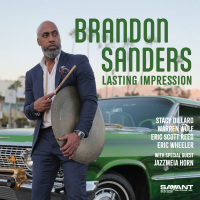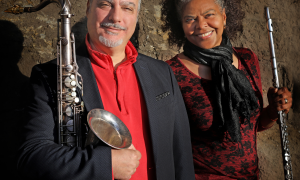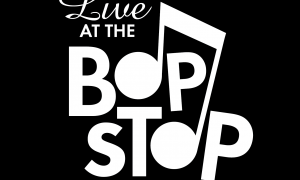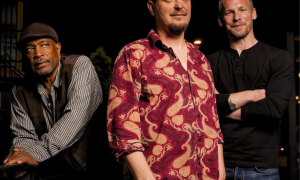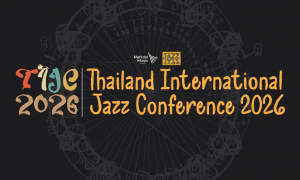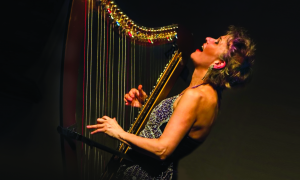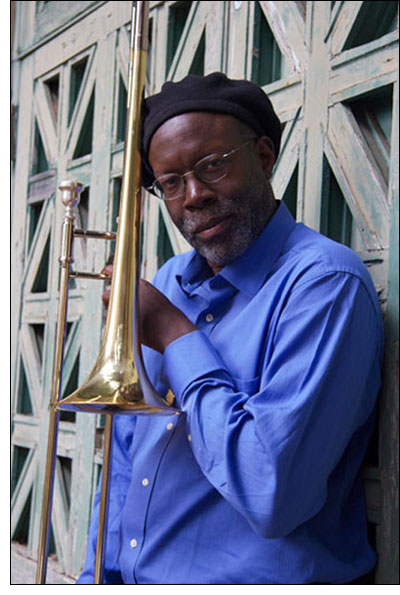
The evolution of jazz charges into the future with the ferocity of a tidal wave, and the strongest musicians ride the momentum into the future. The conglomeration of musical styles and improvisational approaches that shape emerging trends in jazz push the musician through a test of flexibility and durability. Sometimes the musician successfully sails over the crest of these diverse sounds with immense skill, while at other times they fall into the depths of the sea. Like any good surfer, jazz musicians don't let the wave dictate their direction completely though. It simply becomes a route to a larger destiny that both informs and influences their musical vision. As they reach the shore, they arrive with a solid concept that resonates with an intelligent voice and a defined personality.
Trombonist and composer Wayne Wallace rode the wave of jazz history, eventually putting himself on a path to change the course of that legacy on the West Coast. Growing up during the fifties in San Francisco, Wallace soaked up the sounds of his parent's record collection, which contained a strong dose of jazz artists such as Charlie Parker and Duke Ellington. He played piano casually, spending most of his time with sports until the trombone captured his attention in elementary school. Wallace continued playing music in school, having the good fortune of several influential teachers that exposed him to modern jazz. All the while, San Francisco's diverse and creative music scene swirled around Wallace, allowing him to follow his interests in several different directions. He dove headfirst into Sly And The Family Stone, James Brown, and Blood, Sweat, And Tears, while spending time at jazz jam sessions in the Fillmore District. While still a teenager, Wallace worked his way into the Musician's Union and earned some professional gigs. With his sights firmly focused upon a career in music, he attended San Francisco State University, where he refined his technique through classical studies with Will Sudmeier. He balanced his studies with regular work in a Top 40 band, which found a regular gig on Broadway Street, surrounded by jazz clubs. He frequented the jazz venues on breaks and nights off, checking out Bobby Hutcherson, Art Pepper, and many more. Wallace gained another important mentor in trombonist Julian Priester when Herbie Hancock's Mwandishi sextet became based in San Francisco, connecting him with contemporary fusion. With a long artistic path ahead of him, Latin music slowly crept into Wallace's musical world, foreshadowing the important work ahead of him.
Wallace's developmental years as an artist were much more than a regimen of technical studies; it was a time of exploration and experimentation reflective of the era in jazz history. He rode through the wide-open waters established in jazz during the sixties and seventies, arming himself with a broad palette and a creative spirit. In part one of our interview with Wallace, we talked about his early exposure to jazz, his move towards music, and the influence of the San Francisco Scene upon his development. Today, we take a look at his formal training at San Francisco State University, his transparent movement between pop and jazz, as well as his connection with important musicians like Julian Priester.
LATIN JAZZ CORNER: How did you make the transition from a teenager strongly immersed in music to a college student doubling as a professional?
WAYNE WALLACE: I went to James Denmen Middle School, and we had a good music teacher there named Jack Pereira. He was really flexible about letting us play during lunchtime, and just letting us come in there and hang out. So we'd do our little jazz thing, and we'd do our little rock thing. That led me to go to Balboa High School, which is where some of the members of Malo and Sly And The Family Stone had gone or were going to school.
Sid Walker was the music teacher there. At lunch, he'd let us come into his office and hang out; we'd listen to Coltrane records and Ellington records. I remember asking him at one point, “What's it like to be a professional musician?" He said, “Well, it's kind of hard, you do this, you do that." I said, “Well, I want to be one." He said, “Are you sure?" I said, “Yea." He goes, “O.K., well, here's what you've got to do." So he started introducing me to jazz harmony. He was actually the hippest high school teacher that I've ever had. He was the type of cat that would sweat at the students, tell them they were screwing up, and then pat them on the back at the same time. He'd have cutting sessions with the students. We were doing “Move" off Birth of The Cool and I remember him having a cutting session with the saxophonists seeing who could play the head the fastest.
I was in a golden era. I'm 58 now and I keep telling my students that I was so blessed to come up in a golden era. In my first year at Balboa High School, Calvin Simmons was a senior. This was before he went off with Seiji Ozawa and became the conductor of the Oakland Symphony. During his senior year at Balboa High School, Calvin Simmons was playing vibes and piano in the jazz band, he was playing french horn in the concert band, singing in the choir, and he was conducting the orchestra. How's that for a role model?!? Everyone knew how talented he was. I make this analogy to my students—if you were hanging around Michael Jordan for three years, your game would be elevated. So I had all of those blessings around me before I went to San Francisco State.
LJC: You must have had some strong skills as a high school student; what drew you towards San Francisco State?
WW: My first year at State was the Fall of 1970. One of the reasons that I went to San Francisco State was because they offered me a soccer scholarship. Two schools offered me a soccer scholarship and one was on the East Coast—Bowdoin. My mother didn't want me to go to the East Coast, so she said, “You're going to San Francisco State!" I said, “O.K., fine," and I went there.
My house was in walking distance of San Francisco State, so I was walking down there to register in June. As I was walking down towards 19th Avenue, I see all these people running the other way towards me. You know why they were running towards me? The Students For A Democratic Society riots at San Francisco State—it was that year! S.I. Hayakawa was still the president of San Francisco State, and John Handy was still the only jazz instructor there in the music department. That was my first year getting down there.
I had a great background and pedigree to build off of. My problem was that I didn't have a trombone instructor until I got to San Francisco State. The trombone instructor who was very paternalistic to me was Will Sudmeier. He saw that I was a raw talent and that I hadn't had that background. He really sat me down and got me into the basic trombone etudes and studies. By my junior year, I could actually play a classical etude when I had to do my junior recital. He was very good about that. He was kind of a latent guy that wanted to play jazz. He was playing with the San Francisco Symphony, a wonderful musician. He took great care of me, I'm very thankful to him.
At the same time, a lot of people in Bobby Hutcherson's band were also studying there, so I started hanging out with Bobby Hutcherson's band. That was another great lesson—I wasn't playing with them, but when they play at a club, I would be there all five nights, listening to every set.
Of course, I was actively playing in the practice rooms and studying with people. I was doing sixteen units of studies at San Francisco State at the same time; it was a beautiful thing because I was getting my classical studies at San Francisco State. During the day, our big thing was to get in the practice room and play jazz tunes for hours. All the horn players could play piano, so some horn player would be working on their instrument while the other horn player was comping on piano. Then we'd trade off. Unfortunately, then we'd have to go to class!
Somewhere around that time, I was working in a Top 40 band called Badwater Bridge. It was one of the first inter-racial bands to break the color barrier in the Peninsula. We played this club called The Putter in Burlingame. The gentleman that booked us there was named Chuck Koch. He eventually was one of those pioneers that helped break the color barrier in the Peninsula. We had a lead singer was African-American, and of course, I was African-American. No one had done that up to that point. We were just doing our thing—we were young, we didn't know. We were doing Chicago tunes, Blood, Sweat, And Tears tunes, and things that people wanted to hear. We were a big hit.
We came to The Peppermint Tree on Broadway and we were kind of like Ellington's band—I think we played there for two years. Being on Broadway in 1970, you should have seen all the people that came through that club at one point or another. Bobby Freeman was working down the street at the Condor. I remember vividly that he would always come up and just hang out. He came up one night and said, “Drinks for everybody, I'm buying!" I eventually found out that he had received his first royalty check for Bette Midler recording “Do You Want To Dance."
The band that I was in, we were all jazz heads, even though we were playing R 'n B and funk. On our breaks, we would walk up to Keystone Corner—we knew the bouncer up there and he would let us walk in the club and just sit and listen to whoever was playing. We had that advantage. The Jazz Workshop was down the block; the old Matador was down the block. On our breaks, we got to hear everybody.
Everybody came into that club—Broadway was just the place to be at that time. It was right place, right time. I remember Steve Turre sitting in with us, and Art Pepper sat in with us at one point. We were doing the Bitch's Brew thing—the band could do that whole thing. We were like, “Great, Art Pepper— bebop, let's go!"
LJC: Jazz was moving into fusion, was that really happening on the San Francisco scene?
WW: Oh yea, it was a beautiful thing. I was going to The Fillmore, Winterland, or any other place that I could go where there was good music. There was an old club called Pepperland—I saw Cold Blood and Tower Of Power on a double bill at Pepperland in 1973.
LJC: Sometime aorund there you hooked up with Julian Priester too.
WW: The Mwandishirecord came out in 1970, and they did a concert at San Francisco State. That was the first time that I met Julian. Once again, he started mentoring me—like I said, I've had great mentors. They were based in San Francisco at the time because David Rubenson was producing all those records at The Automat. They were based here, so no matter where they went out and toured, they'd come back. I'd take lessons from Julian, and I'd go hear Herbie's band every chance that I could. For me, it was osmosis—a lot of that stuff just sunk in outside of practice and studying.
LJC: Latin music was big in San Francisco during the seventies because of Santana—were you involved in that yet or was that on the outside of what you were doing?
WW: That was on the outside at that point. I was totally aware of it. In the Top 40 bands, we were doing Santana tunes. Until “Everybody's Everything" came out, when they used the Tower Of Power horn section, I just kind of played some percussion or hung out; it wasn't like we were an integral part of the music.
Trombonist and composer Wayne Wallace rode the wave of jazz history, eventually putting himself on a path to change the course of that legacy on the West Coast. Growing up during the fifties in San Francisco, Wallace soaked up the sounds of his parent's record collection, which contained a strong dose of jazz artists such as Charlie Parker and Duke Ellington. He played piano casually, spending most of his time with sports until the trombone captured his attention in elementary school. Wallace continued playing music in school, having the good fortune of several influential teachers that exposed him to modern jazz. All the while, San Francisco's diverse and creative music scene swirled around Wallace, allowing him to follow his interests in several different directions. He dove headfirst into Sly And The Family Stone, James Brown, and Blood, Sweat, And Tears, while spending time at jazz jam sessions in the Fillmore District. While still a teenager, Wallace worked his way into the Musician's Union and earned some professional gigs. With his sights firmly focused upon a career in music, he attended San Francisco State University, where he refined his technique through classical studies with Will Sudmeier. He balanced his studies with regular work in a Top 40 band, which found a regular gig on Broadway Street, surrounded by jazz clubs. He frequented the jazz venues on breaks and nights off, checking out Bobby Hutcherson, Art Pepper, and many more. Wallace gained another important mentor in trombonist Julian Priester when Herbie Hancock's Mwandishi sextet became based in San Francisco, connecting him with contemporary fusion. With a long artistic path ahead of him, Latin music slowly crept into Wallace's musical world, foreshadowing the important work ahead of him.
Wallace's developmental years as an artist were much more than a regimen of technical studies; it was a time of exploration and experimentation reflective of the era in jazz history. He rode through the wide-open waters established in jazz during the sixties and seventies, arming himself with a broad palette and a creative spirit. In part one of our interview with Wallace, we talked about his early exposure to jazz, his move towards music, and the influence of the San Francisco Scene upon his development. Today, we take a look at his formal training at San Francisco State University, his transparent movement between pop and jazz, as well as his connection with important musicians like Julian Priester.
LATIN JAZZ CORNER: How did you make the transition from a teenager strongly immersed in music to a college student doubling as a professional?
WAYNE WALLACE: I went to James Denmen Middle School, and we had a good music teacher there named Jack Pereira. He was really flexible about letting us play during lunchtime, and just letting us come in there and hang out. So we'd do our little jazz thing, and we'd do our little rock thing. That led me to go to Balboa High School, which is where some of the members of Malo and Sly And The Family Stone had gone or were going to school.
Sid Walker was the music teacher there. At lunch, he'd let us come into his office and hang out; we'd listen to Coltrane records and Ellington records. I remember asking him at one point, “What's it like to be a professional musician?" He said, “Well, it's kind of hard, you do this, you do that." I said, “Well, I want to be one." He said, “Are you sure?" I said, “Yea." He goes, “O.K., well, here's what you've got to do." So he started introducing me to jazz harmony. He was actually the hippest high school teacher that I've ever had. He was the type of cat that would sweat at the students, tell them they were screwing up, and then pat them on the back at the same time. He'd have cutting sessions with the students. We were doing “Move" off Birth of The Cool and I remember him having a cutting session with the saxophonists seeing who could play the head the fastest.
I was in a golden era. I'm 58 now and I keep telling my students that I was so blessed to come up in a golden era. In my first year at Balboa High School, Calvin Simmons was a senior. This was before he went off with Seiji Ozawa and became the conductor of the Oakland Symphony. During his senior year at Balboa High School, Calvin Simmons was playing vibes and piano in the jazz band, he was playing french horn in the concert band, singing in the choir, and he was conducting the orchestra. How's that for a role model?!? Everyone knew how talented he was. I make this analogy to my students—if you were hanging around Michael Jordan for three years, your game would be elevated. So I had all of those blessings around me before I went to San Francisco State.
LJC: You must have had some strong skills as a high school student; what drew you towards San Francisco State?
WW: My first year at State was the Fall of 1970. One of the reasons that I went to San Francisco State was because they offered me a soccer scholarship. Two schools offered me a soccer scholarship and one was on the East Coast—Bowdoin. My mother didn't want me to go to the East Coast, so she said, “You're going to San Francisco State!" I said, “O.K., fine," and I went there.
My house was in walking distance of San Francisco State, so I was walking down there to register in June. As I was walking down towards 19th Avenue, I see all these people running the other way towards me. You know why they were running towards me? The Students For A Democratic Society riots at San Francisco State—it was that year! S.I. Hayakawa was still the president of San Francisco State, and John Handy was still the only jazz instructor there in the music department. That was my first year getting down there.
I had a great background and pedigree to build off of. My problem was that I didn't have a trombone instructor until I got to San Francisco State. The trombone instructor who was very paternalistic to me was Will Sudmeier. He saw that I was a raw talent and that I hadn't had that background. He really sat me down and got me into the basic trombone etudes and studies. By my junior year, I could actually play a classical etude when I had to do my junior recital. He was very good about that. He was kind of a latent guy that wanted to play jazz. He was playing with the San Francisco Symphony, a wonderful musician. He took great care of me, I'm very thankful to him.
At the same time, a lot of people in Bobby Hutcherson's band were also studying there, so I started hanging out with Bobby Hutcherson's band. That was another great lesson—I wasn't playing with them, but when they play at a club, I would be there all five nights, listening to every set.
Of course, I was actively playing in the practice rooms and studying with people. I was doing sixteen units of studies at San Francisco State at the same time; it was a beautiful thing because I was getting my classical studies at San Francisco State. During the day, our big thing was to get in the practice room and play jazz tunes for hours. All the horn players could play piano, so some horn player would be working on their instrument while the other horn player was comping on piano. Then we'd trade off. Unfortunately, then we'd have to go to class!
Somewhere around that time, I was working in a Top 40 band called Badwater Bridge. It was one of the first inter-racial bands to break the color barrier in the Peninsula. We played this club called The Putter in Burlingame. The gentleman that booked us there was named Chuck Koch. He eventually was one of those pioneers that helped break the color barrier in the Peninsula. We had a lead singer was African-American, and of course, I was African-American. No one had done that up to that point. We were just doing our thing—we were young, we didn't know. We were doing Chicago tunes, Blood, Sweat, And Tears tunes, and things that people wanted to hear. We were a big hit.
We came to The Peppermint Tree on Broadway and we were kind of like Ellington's band—I think we played there for two years. Being on Broadway in 1970, you should have seen all the people that came through that club at one point or another. Bobby Freeman was working down the street at the Condor. I remember vividly that he would always come up and just hang out. He came up one night and said, “Drinks for everybody, I'm buying!" I eventually found out that he had received his first royalty check for Bette Midler recording “Do You Want To Dance."
The band that I was in, we were all jazz heads, even though we were playing R 'n B and funk. On our breaks, we would walk up to Keystone Corner—we knew the bouncer up there and he would let us walk in the club and just sit and listen to whoever was playing. We had that advantage. The Jazz Workshop was down the block; the old Matador was down the block. On our breaks, we got to hear everybody.
Everybody came into that club—Broadway was just the place to be at that time. It was right place, right time. I remember Steve Turre sitting in with us, and Art Pepper sat in with us at one point. We were doing the Bitch's Brew thing—the band could do that whole thing. We were like, “Great, Art Pepper— bebop, let's go!"
LJC: Jazz was moving into fusion, was that really happening on the San Francisco scene?
WW: Oh yea, it was a beautiful thing. I was going to The Fillmore, Winterland, or any other place that I could go where there was good music. There was an old club called Pepperland—I saw Cold Blood and Tower Of Power on a double bill at Pepperland in 1973.
LJC: Sometime aorund there you hooked up with Julian Priester too.
WW: The Mwandishirecord came out in 1970, and they did a concert at San Francisco State. That was the first time that I met Julian. Once again, he started mentoring me—like I said, I've had great mentors. They were based in San Francisco at the time because David Rubenson was producing all those records at The Automat. They were based here, so no matter where they went out and toured, they'd come back. I'd take lessons from Julian, and I'd go hear Herbie's band every chance that I could. For me, it was osmosis—a lot of that stuff just sunk in outside of practice and studying.
LJC: Latin music was big in San Francisco during the seventies because of Santana—were you involved in that yet or was that on the outside of what you were doing?
WW: That was on the outside at that point. I was totally aware of it. In the Top 40 bands, we were doing Santana tunes. Until “Everybody's Everything" came out, when they used the Tower Of Power horn section, I just kind of played some percussion or hung out; it wasn't like we were an integral part of the music.







